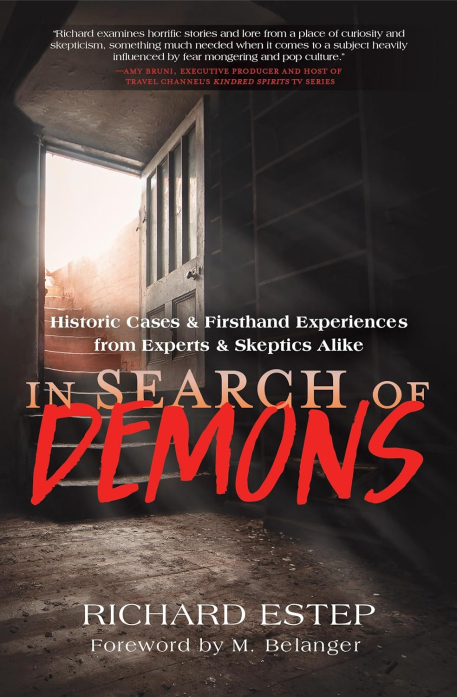
Reviewed by Nemo C. Mörck
The author, Richard Estep, has been a paranormal investigator for 27 years or so. He has appeared in several paranormal shows and has written a number of books, both fiction and non-fiction. I have admittedly not watched any of them or read any of his previous books. Readers may recognize many others in this book from TV, such as Michelle Belanger, occult researcher (and more). Belanger has written the foreword and rightly notes that demons is a contentious topic. Estep is introduced as “an open-minded explorer” (p. xii) and I think that is a fair characterization. Judging by the book, he is willing to listen respectfully and consider different perspectives. Concerning demons, he writes “I remain open to the possibility that they might exist, but I am equally ready to accept that they may not” (p. 5).
From my perspective, demonic possession can be regarded as a syndrome, but it is foremost an interpretation. In line with this, Ciaran O’Keeffe, the parapsychologist, remarks: “In the contexts of hauntings, demons are very much a North American finding” (p. 213). Perhaps the Warrens deserve blame for this. The Warrens, Ed and Lorraine, were well-known demonlogists: “Some venerate and idolize them as pioneers and trailblazers … others decry them as frauds and charlatans” (p. 7). Estep writes about them ”.. their impact on the public’s perception of demons, possession, and demonic hauntings is undeniable” (p. 10). and the notorious Amityville case (Jay Anson wrote a book about the curious case, reviewed by Morris, 1978). However, he seems eager to move on and search for signs of demons elsewhere.
Naturally, if demons truly exists one would expect to find signs all over the world. Estep discuss this with the folklorist Jeff Belanger. During their conversation Belanger point out that demons can serve as scapegoats. Today this is related to the insanity plea and Estep goes on to cover the Villisca Axe Murders. One of the main suspects, Rev. Lyn George Kelly, blamed a mysterious shadow and claimed that it had urged him to “slay utterly” (p. 31). Estep is the kind of researcher that likes to visit places himself and talk to people, hence after having learned that a demon allegedly had taken up residence in the cellar he went there to investigate. He has written about this before (i.e. Estep, 2020). During their talk Belanger pointed out that we like to be scared. This is probably partly why this kind of cases fascinate people.
When Estep learned about another house allegedly infested by a demon he went there to investigate with friends. They ran some spirit box and EVP sessions, but the results were not too interesting. However, Estep relates that two psychic mediums called to warn him during his stay and both described “… a very tall, thin, human-shaped figure with sticklike dimensions, eerily long fingers that resemble claws, and glowing red eyes” (p. 50). Later, on his way home one of his car's wheels basically exploded.
Estep shift gears and relates what he learned during a conversation with Karen A. Dahlman, a psychotherapist. She has specialized in treating Dissociative Identity Disorder (DID, formerly known as multiple personality disorder). The possible relevance of DID to demonic possession has been recognized before (e.g., Spanos, 1996). However, DID is a controversial diagnosis. O’Keeffe remarks that sceptics likes to also put forth Tourette syndrome and schizophrenia as possible explanations. For the sake of argument, let us assume that someone with one of these conditions undergoes an exorcism that seems to be successful. What would that mean?
Estep discuss with Jason Hawes, a ghost hunter, and later with Bishop Bryan Oullette, an exorcist. He then turns his attention to Earling, an old case of demonic possession from the 1920s. A book, Begone Satan!, by Rev. Carl Vogl, made the case known. Estep covers the case and discuss it with a writer, Frank Andersson and with Joseph Laycock, associate professor of religious studies at Texas State University. Laycock (2020) has written about the case and takes the time to also discuss the so-called devils of Loudun (Huxley, 1952).
During his search for answers Estep interviews a number of people (only a few are mentioned in this review) and considers different perspectives. He also ends up paying attention to the notorious Ouija boards. I found the sections about this to be as interesting since I had never read about the Zozo phenomenon (Evans & Guiley, 2016) before. Estep writes well and generously shares what he learned during his search. At the end he remains ”undecided about the objective reality of demons” (p. 268). However, that is understandable. Some parts of this book are certainly harder to believe than others, but I was not there. This is not a scholarly tome peppered with footnotes - it is more like following someone on a road trip. I found the book enjoyable.
References
Estep, R. (2020). A nightmare in Villisca: Investigating the haunted axe. Independently published,
Evans, D., & Guiley, R. E. (2016). The Zozo phenomenon. Visionary Living.
Huxley, A. (1952). The devils of Loudun. Chatto & Windus.
Laycock, J. (2020). The secret history of the ‘Earling exorcism’. In G. Giordan & A. Possamai (Eds.). The social scientific study of exorcism in Christianity (pp. 17-32). Springer.
Morris, R. L. (1978). [Review of the book The Amityville Horror, by Jay Anson]. Skeptical Inquirer, 2(2), 95-102.
Spanos, N. P. (1996). Multiple identities and false memories. American Psychological Association.

